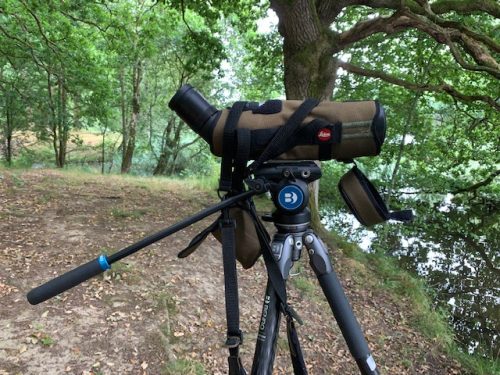Looking for the best tripod for birdwatching? If yes, read on this comprehensive buying guide is for you.
A dependable tripod is a vital tool for birdwatching. It provides the stability to support binoculars, spotting scopes, or cameras. With the right tripod, you will enjoy sharper images, longer viewing sessions without fatigue, and the freedom to focus on the birds, whether scanning the treetops for a rare warbler or watching a hawk soar against the horizon.
What Makes a Tripod Ideal for Birdwatching?
For a tripod to be ideal for birdwatching, it should have the following features:
1. Lightweight Design: The tripod should have a lightweight design for easy transportation from one point to the other.
2. Durable Construction: Moreover, the best tripod for birdwatching should have a robust construction that guarantees durability.
3. Stable Design: It is also important that the tripod is built with solid leg locks, wide leg diameter, and rubber or spiked feet for terrain grip.
4. Adjustable Height: This ensures easy viewing for ground, low-angle viewing, and high-angle viewing.
5. High Payload Capacity: Check your scope/binocular weight and get a tripod that supports at least 1.5–2x that weight for stability.
Best Tripods for Birdwatching
With so many options available, from lightweight travel models to robust full-size tripods, here are the best tripods for birdwatching suitable for you.
1. Vortex Radian Carbon Tripod Kit
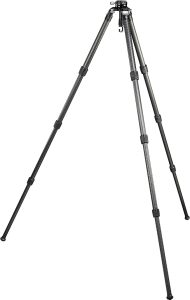
Key Features
- Compatible Devices: Camera, Spotting Scope, Binoculars
- Item Weight: 6.1 Pounds
- Maximum Weight Recommendation: 44 Pounds
- Folded Size: 25.5 inches (h) x 6.0 inches (w)
The Radian Carbon Tripod Kit with a Leveling Head is the best tripod for birdwatching. It changes the rules when it comes to getting the utmost finesse out of a rock-solid platform.
This tripod is built with versatility in mind. It is compatible with a range of cameras, spotting scopes, and binoculars to ensure that you get the most out of your birding expeditions. Furthermore, the fully carbon fiber legs and aluminum construction make for an extremely high strength-to-weight ratio, supporting a 44 lb. max load while keeping the kit easy to pack.
Along with great strength, you get great precision with an integrated level that is perfect for large binoculars, spotting scopes, or as a rifle stand. The interchangeable rubber & spiked feet, 3-angle leg pivot locks, and a detachable counterweight provide stability.
More importantly, the leveling head offers smooth, intuitive control with rubberized, twist-to lock handle, and +/- 15° of leveling capability to guarantee precise positioning. Each of the four tripod leg sections can be extended to adjust the tripod’s height. Additionally, the leg sections can be adjusted out to 85°, 55°, or 25° to accommodate different viewing angles.
Pros
- Compatible with a wide range of optics
- Lightweight and portable
- Great precision with an integrated level
- Robust construction
- Extreme strength-to-weight ratio
Cons
- Big budget
2. INNOREL NT404C Carbon Fiber Tripod
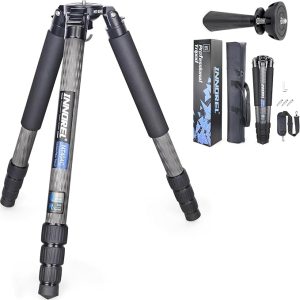
Key Features
- Material: Aluminum, Carbon Fiber
- Weight Limit: 30 Kilograms
- Maximum Height: 63 Inches
- Tripod Head Type: Ball Heads
The INNOREL NT404C Carbon Fiber Tripod is a professional-grade support system designed to meet the demands of birders, photographers and videographers seeking stability and versatility.
Constructed with high-quality carbon fiber, the tripod boasts a maximum leg tube diameter of 40mm. It is robust enough to support equipment weighing up to 66 pounds (30kg). Despite its sturdy build, it remains relatively lightweight at 5.3 pounds (2.4kg) and folds down to a compact length of 22.8 inches (58cm) for convenient transportation.
Furthermore, the tripod features four-section legs with twist locks that allow for independent adjustment, extending from a minimum height of 5.3 inches (13.5cm) to a maximum of 63 inches (160cm). This range accommodates various shooting angles and scenarios, from low-angle macro shots to eye-level portraits.
Another feature that enhances the tripod’s functionality is its user-friendly design. The inclusion of interchangeable screw-in rubber and stainless steel spikes ensures adaptability across different terrains, providing stability on both smooth and uneven surfaces. Furthermore, the 75mm universal bowl adapter facilitates quick leveling, a crucial aspect for videography and panoramic photography.
Above all, this tripod incorporates a 3/8″ screw hole for attaching external equipment, with a provided conversion screw to accommodate 1/4″ attachments.
Pros
- Compact and lightweight
- Durable and reliable build quality
- Multi-angle shooting
- User-friendly design
Cons
- Lacks a hook for adding weight to increase stability
3. Vanguard VEO 2 PRO 233CO Tripod
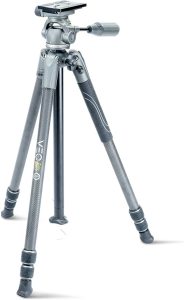
Key Features
- 3 mm, 3 Section Carbon Fiber Legs
- Folded Height: 22″.
- Extended Height: 57.5″
- Weight: 3.2 Pounds
- Max. Load Capacity: 8.8 Pounds
4. FatBoy Tripods Elevate Two Section Tripod
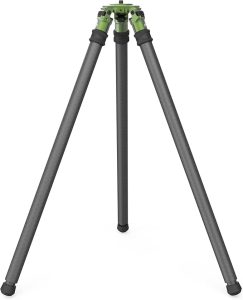
Key Features
- Material: Aluminum, Carbon Fiber
- Item Weight: 4.22 Kilograms
- Weight Limit: 5 Pounds
- Maximum Height: 71.5 Inches
- Tripod Head Type: Ball Heads
When it comes to portability and versatility, the FatBoy Tripods Elevate Two Section Tripod is hard to beat. It boasts a lightweight construction, which significantly enhances its portability without sacrificing strength or durability.
Whether trekking through remote landscapes or navigating busy urban environments, the tripod is easily transportable without the burden of excessive weight. Despite its light frame, it is engineered to endure demanding conditions, such as extreme temperatures, rough terrain, and prolonged outdoor exposure. Besides, the robust build ensures it can handle the wear and tear of regular use.
Another standout feature of this tripod is its innovative leg design, consisting of three non-crossing inverted extendable legs. This design allows for incredibly fast deployment, an essential advantage in fast-paced shooting situations. The leg configuration not only contributes to ease of use but also enhances stability across uneven surfaces, ensuring steady support in challenging conditions.
Furthermore, the tripod’s load capacity is equally impressive, thanks to its 42.5mm tube diameter, which allows it to support heavy professional-grade cameras and equipment with ease. This level of strength and stability makes it an ideal choice for photographers and filmmakers who rely on high-performance gear and demand a dependable foundation for their work.
Pros
- Lightweight design
- Versatile use
- Easy to set up
- Impressive load capacity
- Sturdy and stable design
Cons
- Heavy
5. Athlon Optics Midas CF36 36mm Tube Carbon Fiber Tripod
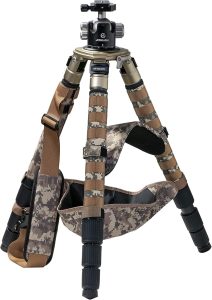
Key Features
- Compatible Devices: Spotting Scope, Camera
- Material: Carbon Fiber
- Item Weight: 1.35 Pounds
- Weight Limit: 66 Pounds
- Tripod Head Type: Ball Heads
Athlon Optics Midas CF36 36mm Tube Carbon Fiber Tripod is the best tripod for birdwatching with a spotting scope.
6. Peak Design Travel Tripod (Carbon Fiber)
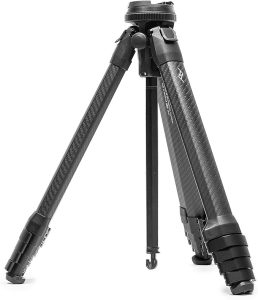
Key Features
- Material: Carbon Fiber
- Item Weight: 1.29 Kilograms
- Weight Limit: 9.1 Kilograms
- Maximum Height: 60 Inches
- Tripod Head Type: Ball Heads
Next, we have the Peak Design Travel Tripod (Carbon Fiber). This tripod stands out as a revolutionary tool for birders who prioritize portability without sacrificing performance.
The most striking feature in this tripod is the incredibly compact design. When collapsed, it has a footprint comparable to a water bottle that makes it easy to pack and carry.
Regarding construction, the tripod is crafted from carbon fiber. It is not only lightweight but also exceptionally sturdy, supporting up to 20 lbs of gear. Moreover, the setup is fast and intuitive thanks to the tool-free, low-profile ball head, which offers smooth and precise adjustments.
The integrated mobile mount hidden in the center column is a thoughtful touch, allowing quick phone shots without needing a separate adapter.
Functionally, the Travel Tripod performs admirably in real-world shooting scenarios. The leg locks are strong and reliable, and the five-section legs provide an impressive maximum height while still maintaining stability. Besides, Peak Design has clearly considered user experience at every turn — from the ergonomic adjustment knobs to the anti-slip feet that provide solid grounding on a variety of terrains.
Pros
- Lightweight
- Easy it is to clean and maintain
- Modular design that enhances longevity
- Replaceable parts
Cons
- Comes at a premium price point
7. Nikon Compact Outdoor Tripod
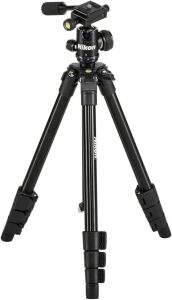
Key Features
- Material: Aluminum
- Item Weight: 16 ounces
- Weight Limit: 5.5 Pounds
- Maximum Height: 31.5 Inches
- Tripod Head Type: Ball Heads
The Nikon Compact Outdoor Tripod is our last recommendation for the best tripod for birdwatching. As a thoughtfully designed piece of gear, it caters perfectly to birders who value portability without sacrificing stability.
This tripod features a lightweight aluminum build that makes it an ideal companion for hiking, travel, or any on-the-go use. It folds down to a compact size that fits into most backpacks. Despite its small footprint, it extends to a respectable height and remains impressively sturdy, even in breezy conditions.
Furthermore, the flip-lock legs are quick to deploy and feel secure once locked in place, offering both convenience and confidence in use. The adjustable ball head provides smooth, precise control for capturing a range of angles, while the quick-release plate ensures fast transitions between shots.
Performance-wise, the tripod delivers reliable support for a variety of optics. It handles moderate weights with ease, making it suitable for long-exposure shots, time-lapses, and landscape photography. Besides, the rubber feet provide solid traction on uneven terrain, and its weather-resistant materials hold up well in outdoor conditions.
Pros
- Built-in bubble level
- Robust construction
- User-friendly design
- Compact, lightweight, and travel-friendly
Cons
- Unsuitable for heavy optics like spotting scopes
Read Also
Criteria for Choosing the Best Tripod for Birdwatching
When buying the best tripod for birdwatching, these are the key factors to consider to ensure you get a stable, durable, and easy-to-use setup that enhances your viewing experience.
Stable Design
One of the most important factors is stability. Birdwatching often requires using high-magnification spotting scopes or binoculars, so a stable tripod is crucial to eliminate vibrations and provide clear, steady images. Look for tripods with sturdy legs and a solid build, especially if you’ll be birdwatching in windy or uneven outdoor environments.
Fabric/Material
Another major consideration is the material of the tripod. Most birdwatchers prefer a lightweight tripod for portability, especially if they hike or move around frequently. Tripods made of carbon fiber are popular because they are both lightweight and strong, although they tend to be more expensive. Aluminum tripods on the other hand are generally heavier but offer good stability at a more affordable price point. Balancing weight and durability based on your typical birdwatching locations is essential.
Height Adjustability
The height and adjustability of the tripod are also important. The best tripod for birdwatching extends to eye level without needing to raise the center column too high. Additionally, a tripod with adjustable leg angles and independent leg movement allows for more flexible positioning on uneven terrain, which is common in nature settings.
Tripod Head Type
This feature plays a significant role in ease of use and precision. For birdwatching, a fluid pan-tilt head or a gimbal head is the best. These allow smooth, controlled movements, making it easier to follow birds in motion. Quick-release plates can also be helpful for fast setup and switching between devices.
Portability
Whether you will watching birds in your backyard or on the go, opt for a tripod that is built with portability in mind. It should fold down into a small size for easy transportation and storage when not in use. Furthermore, the tripod should be light enough to carry from one location to the other with ease.
Ease of Setup
The best tripod for birdwatching is easy to setup and take down with no special tools required. If you travel frequently or go on long hikes, a compact tripod with features such as flip locks for quick leg extension or built-in monopod options can add to the convenience.
Head Type
Lastly, consider the head type the tripod is built with. A tripod head with smooth panning and tilting functionality is crucial for tracking birds in motion.
How to Maintain a Tripod for Birdwatching
Proper care and maintenance of a tripod enhances its longevity while ensuring it stays in shape for optimal functionality. To maintain your birding tripod:
- Clean it Regularly: Regularly clean your tripod, especially the legs and the tripod head, to remove dirt, sand, and moisture.
- Dry it Thoroughly: After cleaning and use in wet conditions, make sure to dry it thoroughly to prevent rust or corrosion.
- Check for Wear and Damage: Regularly check the tripod’s locking mechanisms and leg joints periodically for any wear or damage.
- Proper Storage: When the tripod is not in use, store it in its carrying case .
FAQs
- Do I need a tripod with a specific weight capacity for birdwatching?
Yes. It’s important to match the weight capacity of the tripod to the weight of your binoculars, spotting scope, or camera. A tripod with a higher weight capacity will provide greater stability in different environmental conditions.
- What is the ideal tripod height for birdwatching?
The ideal tripod height depends on your height and glassing style. A tripod with a maximum height that reaches your eye level or slightly higher will allow for a more comfortable birdwatching experience. Look for adjustable tripods that offer flexibility in height settings.
- Can I use a tripod in windy conditions for birdwatching?
Yes. Most tripods are designed for optimal stability in windy conditions. A hook for attaching a weight bag or using the tripod’s lowest leg extension can help provide additional stability during strong winds.
Final Words
Hopefully, you have found this buying guide insightful.
There are many great tripods for birdwatching available on the market and your ideal unit will depend on your budget and birding needs. Look at the attributes that make each tripod the right purchase and choose accordingly.

